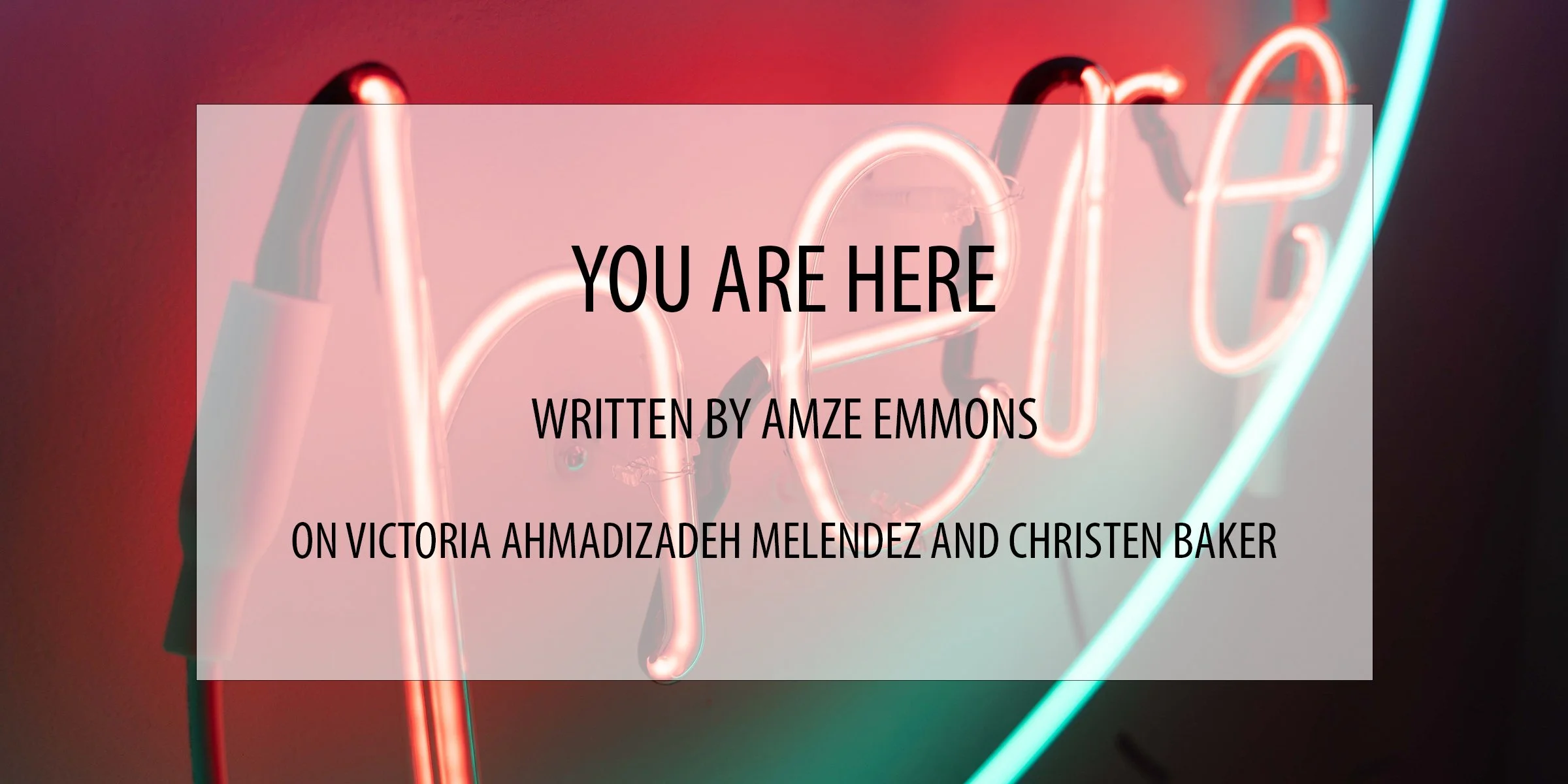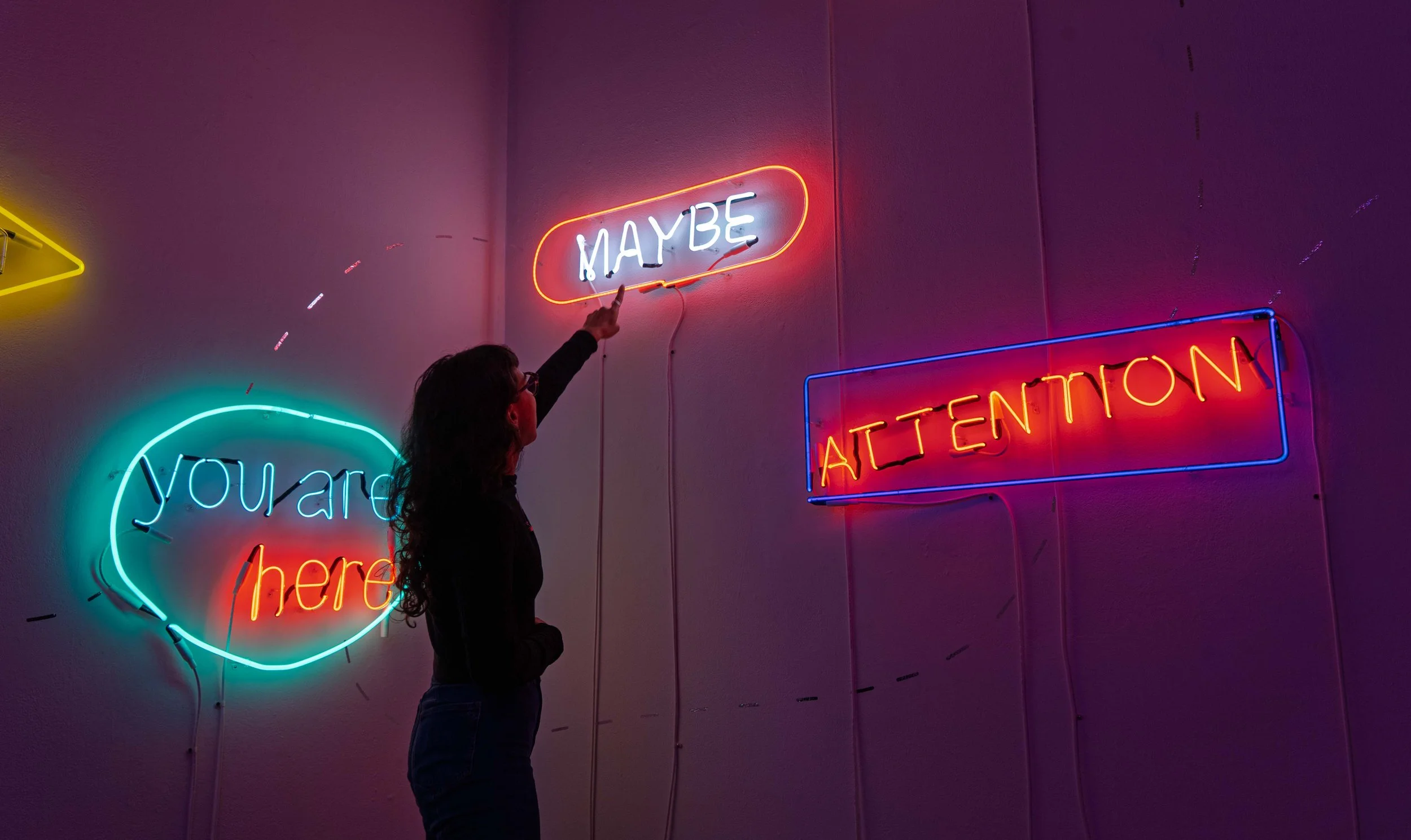You Are Here: Written by Amze emmons on Victoria Ahmadizadeh Melendez and Christen Baker
It’s the extra-natural glow that you notice first.
The gallery is overfull with a cool, lavender glow with no obvious singular source.
The physics of light and color subtly encouraged me into a different state of consciousness; the reality inside of this space was more provisional and less fixed than the drab hallway outside the gallery. And I say space, because through some kind of perceptual magic, Victoria Ahmadizadeh Melendez and Christen Baker made the room disappear altogether. It's nice when an exhibition can start the conversation by bringing the Light and Space movement artists to mind.
Moving past the sensory, YOU ARE HERE greets you with a wide color palette of neon glasswork forming words and short phrases resting securely inside of linear shapes, like text boxes. This language is placed across three walls of the gallery like a star chart. The text boxes range from comic book-style thought and word balloons to hearts and more technical rectangles and lozenge-like forms. Amongst the neon you will see a secondary silvery flicker, which upon inspection reveals itself to be a dashed line of silver foil connecting the words. This installation is a diagrammatic arrangement in the style of a mind map.
The exhibition’s overarching neon work was developed during their Neon as Soulcraft residency at the Museum of Craft and Design. The collaboration was mediated in the tradition of a mentorship, with a seasoned artist sharing their deep knowledge of a craft to an emerging talent, which maps easily over these two artists, with Ahmadizadeh Melendez in a position to share their expertise with Baker, a talented, recent MFA from Tyler School of Art’s Glass program. All in the service of preserving the disappearing tradition of working with neon. The statement notes that they started with the phrase, ‘you are here’ and worked toward each other.
Let’s see, neon, language, mind maps, the perceptual possibilities of light, and a collaborative mentorship and making; all of which invites the viewer to wonder, what is happening here?
At the turn of the last century two scientists figured out that if they trapped atmospheric gases in pressurized glass tubes and fed a current through the space, they could make those gases move in unexpectedly ecstatic ways. Those gases danced with a light no one had ever seen before. Fast forward to mid-century United States and that otherworldly possibility was captured to light the Vegas strip, and a boom in public signage the likes of which no one has seen since. Times change. Now most of what looks like neon is just LED rope lights made by tired hands at the unseen end of a long supply chain. Ahmadizadeh Melendez and Baker are amongst a larger group of dedicated glass artists preserving the history of making with neon, and they are working in the tradition of artists who pick up things that industry has discarded. They are making this familiar material strange and new.
In the installation, neon that you might normally see blinking nostalgically in the background of a neo-noir film, is bent toward making the invisible visible. Mindmaps describe a kind of visible brainstorming or thinking-through that is popular with all sorts of people in a range of jobs, really for anyone who might feel overwhelmed by some aspect of their life. And it turns out that linear outlines don’t align with how many people’s minds associate and organize information. While the term “mind map” came out of 1970s pop psychology, people have long tried to visualize and organize knowledge in a diagrammatic space between picture and language. The artists’ cite, Manuel Lima’s Visual Complexity: Mapping Patterns of Information (2011) as an inspiration for the work, and I would add to that Johanna Drucker’s Graphesis: Visual Forms of Knowledge production (2014), although there are many good books on the topic. A close reader of these books might observe that the forms of these mind maps shift over time to mirror dominant technological metaphors of a given era. It turns out that tools we invent help us imagine new ways of understanding ourselves.
And the style of the mind map created by Ahmadizadeh Melendez and Baker is one strongly informed by both electrical engineering and schematic drawings. When seen in this way the dashed line would indicate a provisional relay, a live wire waiting for its circuit to be connected – clearly a meaningful choice for two artists who began their collaborative project by creating two iterations of the phrase “You are here,” and then continued working toward each other, their collaboration forming a literal circuit of making and mentorship. Or it could just be a side effect of looking at too many electrical lighting diagrams for neon.
Similarly, the approach to language builds meaning through connection with a kind of poetic logic. After starting with the locative, ‘you are here,’ the language quickly veers into word choices that verge on the random, “maybe,” “now,” “wait…,” “attention,” “always,” “desire,”and “then.” It draws to mind cut-up poetry, a Dada practice, popularized by William S. Burroughs, of literally cutting up a physical page of text into paper slips and then performatively selecting the new language from the jumble, which is to say, not random but chance driven. Another turn of the century creative technology invented to make meaning in making, an approach that stacks with the way mentorship and craft build the framework for finding meaning in this installation. And maybe most importantly, in this framework, the audience is building meaning out of this language. We are performing meaning-making as our eyes move around the space trying out word associations, speculating about the choices of the artists; when it seems, their choice was obviously to invite us into the work.
And now I’d like to get back to that glow.
Artists have been making art with text and in the space between text and image for decades upon decades at this point. What makes this show compelling to me is the way that the process and material push me to think about the space between things.
The closing space of expertise in a mentorship. The closing circuit in the language installed in the show. The space between the unseen jumble in our minds and the promise of an organized, schematic mind map. Language moving between fixed meaning and contextual meaning. As a viewer, I feel gently nudged between things, but the interstitial space that floors me in this exhibition is perceptual and chromatic. The neon itself is the true interlocutor here. Unshackled from advertising and camouflaged inside a mind map tactically designed to occupy our busy minds, neon invites our bodies to become fully mesmerized by the dance of these invisible gases made visible through some late 19th-century magic. The glow is a mix of reflected colors, building in waves and particles moving around the small gallery space. For me, standing in the glow, I found an invitation to contemplate this rapidly expanding sense of chromatic wonder, which left me thinking about the value of perception and its limits, of noticing the unseen, the discarded, and completing the ancient circuit of human connection and skill sharing.
Writer Bio:
Amze Emmons is a Philadelphia-based, multi-disciplinary artist with a background in drawing and printmaking. His research interests include wandering and noticing; the politics of architecture; vernacular design; everyday evidence of community; games, play, and generative systems; and tracking the ways Print and Material Cultural history inform our current digital age. He is currently an Associate Professor and Printmaking Program Head at Tyler School of Art and Architecture at Temple University in Philadelphia.













